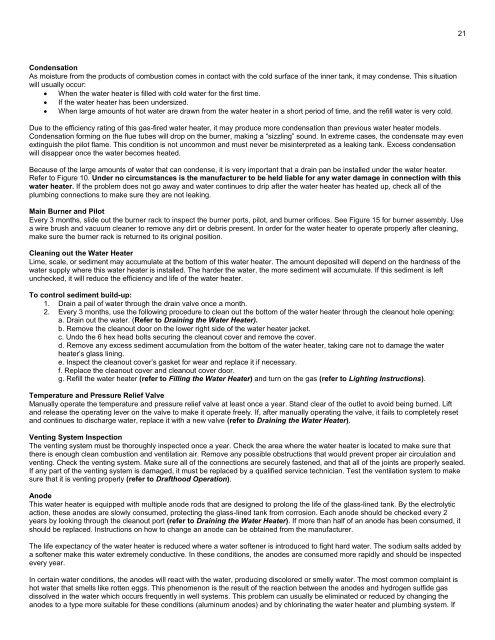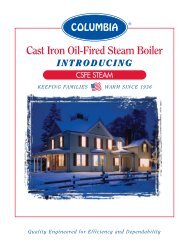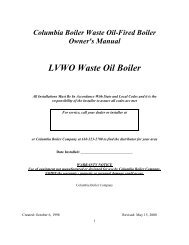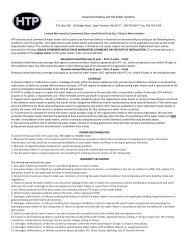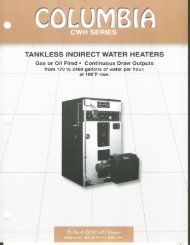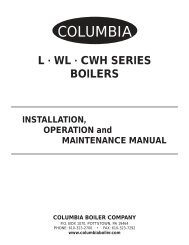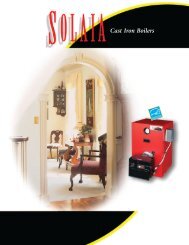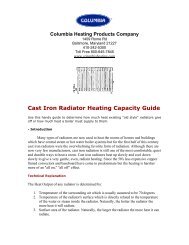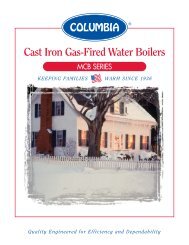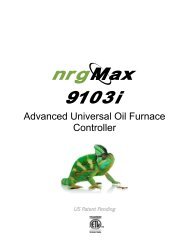Download Installation Manual (.pdf) - Heat Transfer Products, Inc
Download Installation Manual (.pdf) - Heat Transfer Products, Inc
Download Installation Manual (.pdf) - Heat Transfer Products, Inc
Create successful ePaper yourself
Turn your PDF publications into a flip-book with our unique Google optimized e-Paper software.
21CondensationAs moisture from the products of combustion comes in contact with the cold surface of the inner tank, it may condense. This situationwill usually occur: When the water heater is filled with cold water for the first time. If the water heater has been undersized. When large amounts of hot water are drawn from the water heater in a short period of time, and the refill water is very cold.Due to the efficiency rating of this gas-fired water heater, it may produce more condensation than previous water heater models.Condensation forming on the flue tubes will drop on the burner, making a “sizzling” sound. In extreme cases, the condensate may evenextinguish the pilot flame. This condition is not uncommon and must never be misinterpreted as a leaking tank. Excess condensationwill disappear once the water becomes heated.Because of the large amounts of water that can condense, it is very important that a drain pan be installed under the water heater.Refer to Figure 10. Under no circumstances is the manufacturer to be held liable for any water damage in connection with thiswater heater. If the problem does not go away and water continues to drip after the water heater has heated up, check all of theplumbing connections to make sure they are not leaking.Main Burner and PilotEvery 3 months, slide out the burner rack to inspect the burner ports, pilot, and burner orifices. See Figure 15 for burner assembly. Usea wire brush and vacuum cleaner to remove any dirt or debris present. In order for the water heater to operate properly after cleaning,make sure the burner rack is returned to its original position.Cleaning out the Water <strong>Heat</strong>erLime, scale, or sediment may accumulate at the bottom of this water heater. The amount deposited will depend on the hardness of thewater supply where this water heater is installed. The harder the water, the more sediment will accumulate. If this sediment is leftunchecked, it will reduce the efficiency and life of the water heater.To control sediment build-up:1. Drain a pail of water through the drain valve once a month.2. Every 3 months, use the following procedure to clean out the bottom of the water heater through the cleanout hole opening:a. Drain out the water. (Refer to Draining the Water <strong>Heat</strong>er).b. Remove the cleanout door on the lower right side of the water heater jacket.c. Undo the 6 hex head bolts securing the cleanout cover and remove the cover.d. Remove any excess sediment accumulation from the bottom of the water heater, taking care not to damage the waterheater’s glass lining.e. Inspect the cleanout cover’s gasket for wear and replace it if necessary.f. Replace the cleanout cover and cleanout cover door.g. Refill the water heater (refer to Filling the Water <strong>Heat</strong>er) and turn on the gas (refer to Lighting Instructions).Temperature and Pressure Relief Valve<strong>Manual</strong>ly operate the temperature and pressure relief valve at least once a year. Stand clear of the outlet to avoid being burned. Liftand release the operating lever on the valve to make it operate freely. If, after manually operating the valve, it fails to completely resetand continues to discharge water, replace it with a new valve (refer to Draining the Water <strong>Heat</strong>er).Venting System InspectionThe venting system must be thoroughly inspected once a year. Check the area where the water heater is located to make sure thatthere is enough clean combustion and ventilation air. Remove any possible obstructions that would prevent proper air circulation andventing. Check the venting system. Make sure all of the connections are securely fastened, and that all of the joints are properly sealed.If any part of the venting system is damaged, it must be replaced by a qualified service technician. Test the ventilation system to makesure that it is venting properly (refer to Drafthood Operation).AnodeThis water heater is equipped with multiple anode rods that are designed to prolong the life of the glass-lined tank. By the electrolyticaction, these anodes are slowly consumed, protecting the glass-lined tank from corrosion. Each anode should be checked every 2years by looking through the cleanout port (refer to Draining the Water <strong>Heat</strong>er). If more than half of an anode has been consumed, itshould be replaced. Instructions on how to change an anode can be obtained from the manufacturer.The life expectancy of the water heater is reduced where a water softener is introduced to fight hard water. The sodium salts added bya softener make this water extremely conductive. In these conditions, the anodes are consumed more rapidly and should be inspectedevery year.In certain water conditions, the anodes will react with the water, producing discolored or smelly water. The most common complaint ishot water that smells like rotten eggs. This phenomenon is the result of the reaction between the anodes and hydrogen sulfide gasdissolved in the water which occurs frequently in well systems. This problem can usually be eliminated or reduced by changing theanodes to a type more suitable for these conditions (aluminum anodes) and by chlorinating the water heater and plumbing system. If


